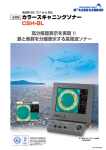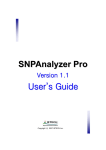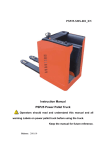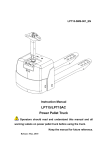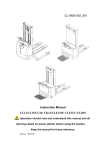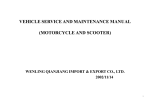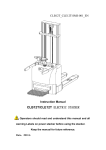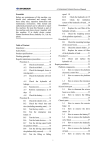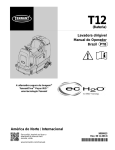Download User manual - Zhejiang Noblelift Equipment Joint Stock Co.,Ltd
Transcript
China Top Brand RT15A-SMS-001_EN Instruction Manual RT15A Reach Stacker Operators should read and understand this manual and all warning labels on the reach stacker before using the stacker. Keep the manual for future reference. Zhejiang Noblelift Equipment Joint Stock Co., Ltd Jingyi Road of Changxing Economic Development Zone, Zhejiang Date:2012.03 Table of Contents INTRODUCTION ..................................................................................................1 1 GUIDELINES FOR SAFE OPERATION....................................................2 2 TECHNICAL MANUAL .................................................................................5 3 TRANSPORT AND TRIAL RUN .................................................................9 4 DRIVING MANUAL ..................................................................................... 11 5 MAINTENANCE, RECHARGING AND REPLACEMENT OF THE ACCUMULATOR................................................................................................16 6 MAINTENANCE AND SERVICE MANUAL ............................................23 Introduction Welcome to use this series of reach stackers. This manual gives clear information on how to master safe operation of the reach stackers. The differences between various reach stackers are described in detail in this manual. During operation and maintenance, please refer to the contents corresponding to the reach stacker types you are using. The safety instructions and important precautions are indicated with the following icons: 1. ---- This icon indicates the existence of a hazard that could result in personal injury if the safety instruction is not observed. 2. ---- This icon indicates that a failure to observe the described instruction could lead to equipment damage. 3. ---- This icon refers to general notes and instructions before use. Most parts of the product are made from recyclable steel. The recycling and disposal of cast-offs resulted during use, maintenance, cleaning and disassembling the product has to comply with local regulations without pollution to the environment. The recycling and disposal of the cast-offs should only be operated by specialised personnel in the designated area. The cast-offs such as hydraulic oil, batteries and electronic units, if improperly disposed, may be hazardous to the environment and human health. Due to continuous product improvement, Noblelift reserves the right to make changes in product designs and specifications without prior notice. For the latest product parameters, please feel free to contact us. Note: All parameters provided herein are as of the publication date of the Instruction Manual. 1 1 Guidelines for Safe Operation 1.1 Requirements for the driver: The stacker should only be operated by personnel trained in operating the stacker. 1.2 The right, duty and responsibility of driver: Clear with his own right and duty, the driver should be trained in operating the stacker and also knows the contents in this operation manual very well. 1.3 Unauthorized persons are prohibited to use: The driver is responsible for managing the stacker in use, and must prevent any unauthorized person from driving or operating the stacker. It’s prohibited to transfer and raise the person by the stacker. 1.4 Malfunction and Defects: In case malfunction or defects occurs with the stacker, the driver should immediately inform the supervisor. If the stacker can not be operated safely, e.g. with worn wheels and brake malfunction, always stop using it until repaired completely. 1.5 Repair:The driver is not allowed to make any repair or change without professional training and clear authorization. The operator is not allowed to change the position of switch, safety devices and so on or make them invalid. All original spare parts from the factory are strictly verified by Quality Assurance Department. Only use spare parts from the manufacturer for the guarantee of the safety and reliability of stacker operation. The replaced material such as oil or fuel should be collected and disposed of according to local environment protection and health regulations. 1.6 Dangerous area: Dangerous area generally refers to these locations, in which reach stacker or its lifting mechanism (e.g. fork or accessories) is moving, lifting or lowering, thus being dangerous to persons in this area, or in which the stacker is handling loads. Generally the scope of this area extends to locations to which the loads or accessories on the stacker is lowered. Unauthorized persons must be ordered to leave dangerous areas. The driver should always give warning if there is any risk of human injury. If the warned persons still stay in dangerous area, the driver should stop the stacker immediately. 1.7 High-risk environment: when working in high risk environments the truck must be equipped with specialized safety device. As working in oil depot, the truck should be equipped with anti-static devices. Ordinary truck usually is not equipped with these devices 1.8 Safety devices and warning signs:Sufficient attention should be paid to safety devices, warning signs and precautions described in above sections in this manual. 2 1.9 Driving in public places: The stacker is prohibited to drive in public places except for special areas. 1.10 Space between vehicles: Remember to keep a proper distance from the vehicle ahead, since it may stop suddenly at any moment. 1.11 Passengers: Never carry or lift person with this stacker. 1.12 Headroom: Never use the stacker in areas where the headroom is lower than the height of overhead guard or mast or loads. 1.13 Operation in a lift or loading platform: If the load capacity of the lift or platform is sufficient and the space is enough for stacker operation, they can be used for transportation with the permission from the stacker user. The stacker must be confirmed by its driver himself before entering the lift or loading platform. When entering the lift, the loads must enter ahead. And locate the stacker in a suitable position to prevent from contacting walls around. If passengers take the lift together with the stacker, they have to enter after the stacker enters and stops firmly, and leave before the stacker. When calculating the weight, it must be the sum total of goods and light weight. 1.14 Driving passageway and working area: The stacker must be driven in designated passageway. Non-related persons must leave the working area. Loads must be stacked in designated locations. 1.15 Operation Management: Driving speeds must be suitable to local conditions. Always drive in lower speed when passing curved passageways, narrow passageways, sight blind spot or rotary doors or any obstructed places. It is prohibited to make an abrupt stop (unless in emergency), rapid U-turn and chase with each other in sight blind spot or obstructed places. Never operate the stacker with the body stretching out of it. 1.16 Visibility: The driver must keep his eyes on moving direction and have a clear view of the road ahead. In case the loads carried block sight of the driver, the stacker has to be driven reversely. If this is not practical, another person should walk in front of the stacker, giving corresponding guidance and warning to the driver. 1.17 Passing a ramp: Only known ramps are permitted to pass. And the ramps must be clean, anti-skid and meet specification requirements of the stacker. Loads on the fork must face the downward slope. Never turn around, drive obliquely or stop on a slope. Pass a ramp in lower speed and get ready for braking at any time. 1.18 Load capacity of the floor: Check if the load capacity of the floor suit for the driving of the stacker . 1.19 Transportation: The fork should be kept lower than 300mm from the floor during non-transportation driving. It is better to driver in reverse direction of the fork to get good vision and mobility. Driving with the fork forward may cause unpredictable mobility problems. 3 1.20 Features of load: The carried goods must be safe and reliable. The height of carried goods should not exceed the height of the fork carrier or backrest. 1.21 Driving on loading platform or approach bridge: Before driving the stacker onto loading platform or approach bridge of a truck, make sure to check the max. load capacity of the approach bridge and if it is equipped with anti-sliding devices. The driver must also check the max. load capacity of the truck or platform and if there are devices such as brake cushion block to prevent the truck or platform from moving. 1.22 Safe Parking: The stacker should be parked in a designated specialized parking area. The parking place should be horizontal and firm. If the stacker is equipped with parking brake device, start this device when parking. Pay attention to safety when parking the stacker. Never park the stacker on a slope or on a ramp. The fork must be lowered down to the lowest position after parking to avoid accident because of sudden lowering. Turn the electric lock to “OFF” position to prevent unauthorized operation. In order to avoid unauthorized personel to use this stacker, the operator should remove the switch key when leaving the position. If the truck will not in use for a period after parking. Such as off work, and does not need to charge, the battery plug should be unplugged. 1.23 Signalling: Warning signals can be sent by the horn on the stacker to catch people’s attention. 1.24 Protection shoes: According to EU standard EN-345:1-S1, standard protective shoes must be worn when operating the stacker. 1.25 Truck modification: No modifications or alterations to a powered industrial truck, which may affect, for example, capacity, stability or safety requirements of the truck, shall be made without the prior written approval of the original truck manufacturer, its authorized representative, or a successor thereof. When the manufacturer or its successor approve a modification or alteration, they shall also make and approve appropriate changes to capacity plate, decals, tags and operation and maintenance handbooks. Only in the event that the truck manufacturer is no longer in business and there is no successor in the interest to the business, the user may arrange for a modification or alteration to a powered industrial truck, provided, however, that the user shall: a) arrange a industrial truck and its safety expert to design, test and complete the modification or alteration; b) maintain a permanent record of the design, test(s) and implementation of the modification or alteration; c) approve and make appropriate changes to the rated capacity plate(s), decals, tags and instruction handbook; d) affix a permanent and readily visible label to the truck stating the manner in which the truck has been modified or altered together with the date of the modification or alteration, and the name and address of the organisation that accomplished the tasks. Failure to comply with these instructions will invalidate the guarantee. The guarantee is also invalidated if the stackers are exported by the customer (or a third party) illegally without the consent of Noblelift. 4 2 Technical Manual RT15A series of reach stacker are designed for short and medium distance high-strength transportation on flat road surface, the max. load capacity can reach 1500kg. 2.1 2.1.1 Technical feature Load capacity under different heights and different load centers Lifting height h3 mm 3000 3300 3500 4000 4500 5000 5300 6000 7000 8000 Load center distance ( C ) mm Actual load capacity ( Q ) kg 1500 1200 1500 1200 1500 1200 1500 1200 1500 1200 1500 1200 1500 1200 1200 900 1000 800 800 600 500 600 2.1.2 Mast parameter Item Dual mast Triple mast Enclosed mast height h1 mm Lift height h3 mm 2100 2250 2350 2600 2850 2230 2400 2565 2730 3065 3400 3000 3300 3500 4000 4500 4500 5000 5500 6000 7000 8000 5 Extended mast height h4 mm 3865 4165 4365 4865 5365 5365 5865 6365 6865 7865 8865 2.1.3 Structure 6 Other Electric motor Performance Dimensions Wheel types Weight Characteristics RT15-A Technical data 1.1 1.2 1.4 1.5 1.6 1.7 Manufacturer`s type designation Drive (battery, diesel, petrol, natural gas,electric) Operator type ((hand, pedestrian, stand-on, sit-down, order-picker) Rated load capacity Load centre distance Distance between fork backrest and front wheel Wheelbase 2.1 Service weight(including battery) 3.1 3.2 3.3 3.4 3.6 3.7 4.1 4.2 4.3 4.4 4.5 4.6 4.7 4.8 4.9 4.10 4.11 4.12 4.13 4.14 4.15 4.16 4.17 5.1 Tyres (rubber, high-elastomer, pneumatic, polyurethane) Tyre size driving wheel Tyre size load wheel Caster wheel (dimensions) Wheels, number front/rear (x=driven wheels) caster/load wheel Tread, front Tread, rear Lowered mast height Free lift height Lift height Extended mast height Height of overhead guard of driving Height of stand board Height of steering wheel Lowest height of fork Overall length L ength between fork backrest and vehicle body Overall width Fork dimensions Fork carriage width Overall fork width Ground clearance Aisle width for pallets 800x1000 lengthways Turning radius Drive speed, laden/ unladen 5.2 5.3 5.4 Gradebility, laden/ unladen 5.5 6.1 6.2 6.3 6.4 6.5 6.6 7.1 7.2 Serivice brake Drive motor Lifting motor Battery acc.to DIN 43531/35/36 A, B, C, no Battery voltage, nominal capacity K5 Battery weight Battery dimensions l /w / h Type of drive control Noise level at operator’s ears 1.3 3.5 RT15A electric Stand-on Q C X y kg mm mm mm 1500 500 180 1482 kg 3500(lifting 5300) mm mm mm polyurethane Φ343×140 Φ267×106 Φ180×70 1x 2 / 2 b10 b11 h1 h2 h3 h4 h6 h7 h14 h13 l1 l2 b1 s/e/l b3 b5 m1 Ast Wa mm mm mm mm mm mm mm mm mm mm mm mm mm mm mm mm mm mm mm km / h 660 1010 See mast table See mast table See mast table See mast table 2330 350 1320 35 1855 1325 1130 35 / 100 / 920 760 760 80 2700 1748 9.5 / 9.5 Lift speed, laden/ unladen mm/s 280 / 310 Lowering speed, laden/ unladen mm/s 350/ 320 % kw kw V/Ah kg mm dB 7 10 / 15 electromagnetic 5.5 8.6 43531 B 48 / 360 660 1020 / 412/ 540 MOSFET Control, AC <70 This table is made according to regulation VDI 2198 , only provides with the technical data of standard stackers. Technical data of non-standard stackers and trucks with accessories or other optionals are different from the table above. We reserve the right to update technical data of this stacker. 48V/360Ah battery is optional, the battery is in accordance with DIN standard, the battery compartment dimension l/w/h is: 1020/ 412/ 500 mm. 2.2 Technical Standards Continuous noise level should be less than 70dB(A) according to ISO4871 standard. Continuous noise level is an average value of noise measured at the driver’s ear during travelling, lifting and being standby. Electromagnetic Compatibility (EMC) The manufacturer confirms that the stacker complies with EN12895 and other relevant standards on limits of electromagnet radiation and interference, and has been tested on static discharge. Never modify any part of electrical system without written permission from the manufacturer. 2.3 Operation Conditions Ambient temperature: 5℃~40℃ Special devices have to be used under a temperature below 5℃ or in very humid environment, Altitude: up to 2000m. If there is a quality problem or need to order spare parts, please indicate the serial number of the stacker and parts number. 8 3 Transport and Trial Run 3.1 Transport with A Crane Load capacity of the crane in use must be sufficient (larger than the net weight of stacker; see the nameplate on the stacker). The hook holes are specially designed for convenient transportation of the stacker. — Park the stacker in a safe position. — Hooks of the crane must be applied at hook holes. Hooks of the crane must be applied at hook holes, ensuring the stacker will not be slipped down. 3.2 Trial Run The stacker can only use accumulator as power supply. Changing to use AC power will damage the electric circuit. Cables connecting the accumulator should be less than six meters. To ensure the normal work of the stacker after delivery or transportation, the following operations have to be completed: — Check the completeness of the stacker and devices. — If necessary, install batteries without damaging the connection cable. — Recharge the accumulator immediately. — If customers want to replace the accumulator with a maintenance-free one, make sure that the new accumulator matches the accumulator coulombmeter (or is permitted by service technician of the manufacturer). 3.3 Towing of Stackers without Driving Ability When towing the stacker without driving ability, release electromagnetic brake before moving. — Press emergency control button and turn the power supply switch to “OFF” position. — Open the cover of electric unit. — Release 3 screws counter clockwise on the electromagnetic brake until the brake does not impede the stacker from moving. Now, you can tow the stacker. After arriving at the destination location, recover the stacker to original status. 9 3.4 Assembling Sometimes, in order to transport conveniently, the mast assemblies are apart. Now, you need to assemble according to the following steps. Some tools are needed, such as hoisting equipment, wrench, etc. 3.4.1 Hoist the mast assemblies together with hoisting equipment. 3.4.2 Fix the mast to the forward frame with two high-strength bolts. Don't forget to assemble washers and spring washers. 3.4.3 Adjust the washer number to make the mast vertical to the ground. 3.4.4 Tighten two bolts. 3.4.5 Connect the oil tube. 10 4 Driving Manual Steering: 180° electric seamless steering, the steering motor will stop automatically when swerving to +90° which eliminates any chance of overload. Driving: 5.5 kW drive motor with powerful driving and convenient acceleration. Helical gears technology of transmission case makes the driving more efficient and energy saving. Hydraulic system: 8.6 kW hoisting motor is efficient and powerful. Sensitive hand control valve allows lowering or lifting speed and height control at will. Brakes: Equipped with two independent braking systems. Regenerative braking, when the operator loosen the speed controller or turn the controller reversely, the motor will run automatically under a generator state so as to realize flexible brake to protect the brake block of the electromagnetic brake and realize energy recovery. Another way of braking is electromagnetic brake, which is only used as a service brake and emergency brake. Three-phase AC technology: The driving motor and steering motor are both use the three-phase AC technology. Compared with traditional DC motor, the motor speed can be regulated smoothly with a wide speed range and high efficiency. Avoiding the trouble of replacing motor carbon brush which relatively realize the maintenance-free of the motor. 4.1 Stacker Appearance and Operation Board Introduction 1 Headlight 2 Display 3 Foot switch 11 11 Horn Button 9 Headlight Switch 8 Key Switch 7 Instrument 6 Emergency Stop Switch 12 Safe Handrail 10 Steering Wheel 1 Headlight 2 Display 3 Foot Switch 4 Speed Controller(accelerator) 5 Control Handle(including lifting and lowering control handle、forward/tilting/sidesway control 5 Control Handle 4 Accelerator handle) 6 Emergency Stop Switch 7 Instrument(shows turning angles of the driving wheel、residual energy、current real-time speed) 8 Power Key Switch 9 Headlight Switch 10 Steering Wheel 11 Horn Button 12 Safe Handrail 12 4.2 Safety features of the stacker The stacker is equipped with adequate safety device to decrease the occurrence of the accidents. A 、When the forks are lifted to 400m and lead magnet steel to go through the surface of magnetic control switch, the driving speed decreases immediately to achieve steady driving and safe operation; when magnet steel lowers with the forks and go through magnetic control switch again, the driving speed recovers. By controlling the fluctuating range of lifting and lowering control handle, it can certainly control the lifting and lowering speed. Speed Limit Switch Magnet Steel Limit Switch The function of this speed limit switch is the same as that of the magnetic control switch in the above picture: making the lifting speed reduce when the forks are lifted to a certain height. Limit switch is on the top, the function is forks can not rise when they are lifted to the highest point and reach the limited lifting height to meet safety operation requirement. Speed Limit Switch B、Move the steering wheel to forward the driving wheel in straight line, the driving speed can reach full speed, when the steering wheel turns for a certain angle, it makes the driving wheel turn a certain angle accordingly to achieve turning effect. In turning process, when driving with the turning angle exceed +20° from the straight line, the speed will decrease accordingly with the different turning degrees, larger turning angle, slower speed in order to achieve stable turning and safe driving. 13 C、 Turn on the power, the system starts self checking, when the electric system has fault, like open circuit, short circuit or the control button is in active state, such as stepping on the foot switch firstly, the speed controller is not in neutral position and so on, the stacker will not work and alarm fault, then only after trouble shooting of the electric system, the stacker can continue to work. D、Operation steps of normal driving: open the emergency stop switch and key switch firstly, and check whether the acceleration handle is in neutral position, it is effective only in neutral position, then step on the foot switch, operate the acceleration handle to drive forward and backward, otherwise the instrument will alarm the following fault: ALARM 79 ON NODE 2 While driving, if you loose the foot switch suddenly, the stacker will brake and stop immediately (the accelerator is not in neutral position now), and the instrument alarms fault, only after the acceleration handle turns back to neutral position, the fault will be eliminated, continue the following operations to avoid misoperation and keep the stacker safer. E、When the battery energy drops to 20%, the instrument flashes, and flashes the fault code "66"on the instrument prompting to perform recharging and lock the lifting function to limit the lifting function of the forks, the stacker now can only drive rather than lifting to avoid safety accidents caused by insufficient energy while lifting, and ensure personal safety, the function recovers after it is fully charged. The truck is equipped with full safety device to minimize the occurrence of accidents. A) When the fork height exceeds 1000 mm, the drive speed will automatically reduce. B) When the steering angle is over ±20°, the drive speed will automatically reduce. C) When the electrical system has faults, the truck will automatically stop. D) The truck can only drive after stepping on the pedal switch. E) Before electrifying ( the power key switch turn to “ON” position), if any control button is active, such as stepping on the pedal switch, the speed controller is not in the neutral position, etc., the truck will not drive. F) If the controller temperature is over 75 ℃, the maximum current will reduce proportional with the increasing of the temperature. The temperature of the controller should not exceed 100 ℃. 14 G) The protection level of the controller is IP54 which can prevent dust invasion and liquid splash. H) When battery power is too low, the maximum current will reduce to half of the maximum current. 4.3 Driving of the stacker Before driving or handling the goods, the operator must ensure that all personnel leave the dangerous zone. A) Turn the key switch to “ON” position when entering the cab. Before electrifying ( key switch turn to “ON” position), if any control button is in active. The security feature will automatically lock the truck after electrifying,. B) Hold the handle of the steering wheel with left hand and grip the speed controller with right hand. C) Step on the pedal switch with left foot to loosen the electromagnetic brake and keep stepping in the process of driving. D) When moving the speed controller forward or backward, the truck will move forward or backward accordingly. The controller moves larger, the drive speed and acceleration are faster. Acceleration and deceleration of the truck should be gentle, do not accelerate or decelerate suddenly. When driving on the slopes, loads on the fork must face the uphill. E) Three braking methods are available: - Brake the truck by reducing the speed potentiometer input or turning the speed potentiometer to the neutral position. This braking method is soft and stable,and should be often used. - Reverse braking, for example, change the driving direction, i.e. move the speed potentiometer in reverse direction. The more the speed potentiometer moved, the faster the brake works. - Put the speed controller in the neutral position first, then release the pedal switch to brake. This method can only be used for emergency braking. Driving in the opposite direction of the fork as much as possible to have a good view and maneuverability. 15 5 Maintenance, Recharging and Replacement of the Accumulator 5.1 Safety Operation Procedures for Lead-acid Accumulator The stacker must be parked in a safe location before any operation is performed on the accumulator. 5.1.1 Maintenance Technician Only qualified technician can perform operations on the accumulator such as recharging, maintenance and replacing. Before operation, carefully read instruction manuals including operation manual, replenishment preparation and recharging requirements. 5.1.2 Fire Prevention Measures Smoke or open fire is forbidden when operating the accumulator. The accumulator should be away from inflammable materials for at least two meters when storage or recharging. The accumulator storage place should be well ventilated and equipped with fire fighting devices. 5.1.3 Maintenance of the Accumulator 1) Keep the nuts on every battery cell dry and clean. Tighten every terminal and cable end and brush them with grease to prevent corrosion. Bared terminals and terminal posts should be covered with an antiskid insulating cover. 2) The cable lines of every two cells should be well-connected. Check the nuts on each pole for loosen or sliding, if happens, tighten the nuts. 3) Keep the surface of accumulator clean and dry. After completing recharging, clean the spilled acid with cotton yarns or brush, and clean with wet towel if necessary. 4)Avoid over recharging and over discharging, and fast charging and insufficient recharging are also not allowed. Otherwise the life span of the accumulator may be affected. 5) It is forbidden to put conductive objects (including metal tools) on the accumulator, or short circuit even explosion may be caused. 6) Never spill any harmful liquid or solid materials on surface of the accumulator. When using a densimeter or a thermometer, make sure the surface is clean and clear. 7) Recharge the discharged accumulator in time. Delayed recharging may damage the accumulator. Do not delay recharging for more than 24 hours. The outdoor accumulator may not easy to charge In cold weather,. In this case, move it indoors to charge. 16 8) If the accumulator won’t be in use for a long time, it should be recharged once every month and fully charged every time. 9) When charging or using, the battery must be supplied with distilled water regularly because of evaporation, you have better check the battery electrolyte weekly, the liquid level must be kept between the highest liquid level and the lowest liquid level of the battery. The supply condition and filling amount of the distilled water are as follows: Battery cover Note:When the electrolyte liquid level is not enough, do not supply acid blindly (test the specific gravity after fully charged), the battery supply must be distilled water. 10) When several battery cells have fault, you should find out fault causes and fault cells immediately and repair. If can not be repaired, change them, monitor vitriol proporation of each cell of the battery with gravitometer regularly (H2SO4 proporation1.27-1.29, fully charged). Gravito meter 17 11) Make sure the ambient environment is well-ventilated while charging, flammable gas (H2O =H2↑+O2↑)may be produced during the battery charging process, prohibit smoking and open fire at site to avoid risk of hydrogen explosion. 12) The electrolyte in the accumulator is toxic and corrosive. For this reason, always wear working clothes and protective glasses to keep your body away from the electrolyte in accumulator under any operation condition. 13) If your clothes, skin or eyes touch acid liquid in accumulator, wash with large amount of clean water. When your skin or eyes touch acid liquid, wash with large amount of clean water and also seek doctor’s treatment immediately. The spilled acid must be neutralized and treated immediately. 14) The weight and dimension of the accumulator have a considerable effect on the stability of the stacker. Therefore do not modify the type of accumulator without the approval of the manufacturer. 15) Never discharge in large current, for example, performs driving and lifting simultaneously. 5.1.4 Disposition of Worn-out Accumulators Scrapped accumulators should be recycled and stored in specified environment protection areas or cast-off treatment zones according to local laws and regulations. These works should be done by qualified specialized companies. 5.2 Specification of the Accumulator Weight and dimension can be found on the nameplate of the accumulator. Uninsulated terminal poles on the accumulator should be protected with an insulated cover. When connecting the accumulator with the socket, make sure the stacker is powered off and the switch is at “0” position. When replacing or assembling the accumulator, make sure the accumulator is fixed securely in battery box. 5.3 Storage, Transportation and Installation of the Accumulator The stacker should be parked on the level ground steadily. To avoid short circuit, the bared cable ends and terminal posts should be covered with insulated covers. When the accumulator is pulled out, arrange the connectors and cables of removed accumulator properly without blocking access 18 of the accumulator. When handling the accumulator with a crane, make sure the load capacity is sufficient (the weight of the accumulator is marked on both the nameplates of the accumulator and the stacker). The hoisting device must be pulled vertically to avoid the damage of the accumulator box. The hooks of the hoisting device should be safe and secure. Never let the hooks fall onto a single battery . —Press emergency stop switch and turn the power switch to “OFF” position. —Step on the battery protection device to release the lock state of the accumulator box. —Remove the connectors of accumulator cables. —Connect the lifting device to hook holes. —pull the accumulator out by side and move it away with handling equipment. 5.4 Instrument Indicator SMART—DISPLAY is an intelligent instrument based on CAN BUS, the instrument can monitor the electric system through real-time monitoring the performance of the whole truck by the bus. 1) Monitor the battery energy, when the battery energy decreases, the instrument will continuously extinguish the LED backlight with a particular algorithm to indicate the residual energy of the battery in order to check the energy. 2) Because the SMART—DISPLAY is a kind of intelligent instruments based on CAN-BUS, it can share data with the controller. The instrument can also indicate the information of the truck in the driving state, such as the angle of guide wheel and driving speed at the same time. 3) Monitor the entire bus system, when there is a failure in the bus node point, the instrument will display in the form of fault code, and the stacker will stop working at the same time until troubleshooting. 19 Instrument Overview Buttons and Figures Description Figure Figures and button names Using methods and functions System self-check lamp The light shines once when opening the key and system conducts self checking . Failure warning light The trouble light flashes indicating that there is a fault of the stacker. Battery energy warning light Energy warning light flashes indicating that battery energy has run out. Brake oil supply warning light Brake oil supply warning light This function is effective when using mechanical brake. Brake light Hand brake the warning light. This function is effective when using mechanical brake. Safety warning light Seat safety switch warning light. This function is effective when using seat safety switch. Number key When the instrument is used as a real-time control instrument of the CAN-BUS network, this key is a keyboard button: ENTER Number key When the instrument is used as a real-time control instrument of the CAN-BUS network, this key is a keyboard button: ROLL UP Number key When the instrument is used as a real-time control instrument of the CAN-BUS network, this key is a keyboard button: ROLL DOW Number key When the instrument is used as a real-time control instrument of the CAN-BUS network, this key is a keyboard button: SET UP 20 Remarks Number key When the instrument is used as a real-time control instrument of the CAN-BUS network, this key is a keyboard button: SET DOWN Number key When the instrument is used as a real-time control instrument of the CAN-BUS network, this key is a keyboard button: OUT Note: The button with warning signs in the remarks column of the above table, do not operate this key by unauthorized personnels of our company. 5.4.1 Indicating Functions 1)Battery energy real-time monitoring display (the position that figure 3 points to) is in the form of 10 segments on the lower part of the screen , each segment represents 10% of the battery energy. As the battery energy reducing, the number of segment represents different battery energy. When the energy remains 20%, the last two segments together with the battery symbol on the instrument panel will start flashing at the same time, warning that the battery discharging approaches the limit and must be recharged immediately. At this time the control system will shut down the lifting function of the stacker, so the stacker can only drive and cannot perform lifting operation. 2)When there is a failure of the truck, the instrument will show fault code in position 3 to 21 facilitate repairing. Note: when there is a low battery energy alarm of the instrument, charge the battery in time to avoid damages caused by over discharging of the battery. 3) Stacker steering position real-time monitoring (the position figure 2 points to) instrument can monitor the steering position of the stacker through CAN-BUS and displays the rough steering position of the stacker in the instrument 2 position in the way of moving segment. 4) The instrument 2 position is the hourmeter display area when starting up. 5)Stacker speed real-time monitoring (the position figure 1 points to) instrument can monitor the driving speed of the stacker through CAN-BUS and displays the speed information to instrument 1 position in the way of number in km/h. 5.5 Battery Charging This stacker is equipped with a specialized charger. Before starting charging, the stacker should be parked in a closed, well ventilated room. In the charging process, the surface of the battery cell should be exposed in the air without cover. Make sure that no conductive objects are placed on the battery, check whether all the connecting part of cables and connectors are firm and reliable. In the charging process, hydrogen will separate out from the battery. Therefore make sure the battery and charging place are well ventilated and strictly control the hydrogen content to ensure safety. Battery charging must follow the relevant instruction manuals of the battery and charger. 5.5.1 Balance Charging In the using process, the efficiency of battery is low when battery voltage, electrolyte and its density of each battery group (unit) may be different. Then balance charging is needed to eliminate inconsistency of each battery group (unit) and make them consistent. Balance charging is also needed in the following situations: 1) Voltage lower than 1.7 V is often happened to battery units in the discharging process. 2) Large current appears in the discharging process, such as driving motor and lifting motor are used at the same time. 3) Battery is not recharged in time after discharging. 22 4) Battery that is not used for a long time should be charged before use. It is suggested to perform balance charging once a month in the using process. 6 Maintenance and Service Manual Never modify any spare parts, especially safety devices of the stacker without permission. Never change the driving speed of the stacker. All spare parts provided by original manufacturer are strictly tested. Only use spare parts from the manufacturer for the guarantee of the safety and reliability of stacker operation. The replaced materials including oil and fuel should be collected and disposed of according to local environment protection and health regulations. 6.1 Safety Procedures for Maintenance and Service Maintenance Technician: The maintenance and service should only be performed by special personnels trained by the manufacturer. After the technician sent by after-sales department of the manufacturer completed maintenance and servicing work, they should sign on the service log. Lifting of the Stacker: When the stacker needs to be raised up for repair, the lifting device must be safe and reliable, and must be strictly fixed to hook holes. When the stacker is raised up, proper measures such as using wedges and wooden blocks must be applied to prevent the stacker from sliding down or tilting over. Cleaning Operation: Flammable liquid can not be used for cleaning the stacker. Before cleaning, take safety precautions to prevent electric sparks (e.g. sparks caused by short circuit). When operating the accumulator, connectors on it must be disconnected. Use tools like soft air suction or compressed air, non-conductive and anti-static brushes to clean electric and electronic components. If you are going to use water spray or high pressure cleaner to clean the stacker, all electric and electronic components must be covered carefully in advance because moisture may cause them malfunction. Never use steam nozzles for cleaning. Operation of Electric System: Operation on the electric system should only be performed by 23 specially trained personnels. Before performing any operation on the electric system, precautions must be made to prevent electric shock. When operating the accumulator, connectors on it must be disconnected. Welding Operation: To prevent electric components from being damaged, remove these electric components before welding. Installation: When repairing or replacing hydraulic components, electric and electronic components, make sure to install them back to their original positions. Wheels: Quality of the wheels has a significant effect on stability and driving performance of the stacker. Modification on wheels can only be performed with the approval from the manufacturer. When replacing wheels, ensure that the stacker is levelled as delivery state (wheels must be replaced in pairs, i.e. replace right wheel together with left one). Lifting Chain and Rollers: Chain and rollers will be worn quickly without good lubrication. Perform periodic lubrication according to the following maintenance table. Shorten the lubrication period under bad operation conditions (such as in dusty and hot environment). Hydraulic Oil Pipes: The hydraulic oil pipes must be replaced every six years. Change the relevant oil tubes of hydraulic system when changing the hydraulic asssemblies. 6.2 Routine Maintenance (Before Every Shift) 6.2.1 Check the liquid level of electrolyte of the accumulator. The liquid level will be higher when recharging. 6.2.2 Check every pole, cable and their covers of the accumulator. 6.2.3 Check if the accumulator box is fixed securely. 6.2.4 Check the stacker for oil leakage. 6.2.5 Check the condition of the lifting chain, rollers, fork, oil pipes and horn. 6.2.6 Check the condition of the brake. 6.2.7 Check the wear and tear of drive wheels and load wheels. 6.3 Professional Maintenance Manual It is very important for safe operation of the stacker to perform overall professional maintenance. Failure in performing maintenance according to specified time intervals may cause 24 malfunctions of the stacker, and potential risks to human and equipments. Maintenance periods listed in this manual apply to single shift a day under normal operation conditions. If using in dusty environment, the ambient temperature varies remarkably or in multi-shift situations, the maintenance period has to be shortened. Maintain the stacker according to the following maintenance list. Maintenance periods are as follows: W1 = Every 50 work hours, but at least once a week. M3 = Every 500 work hours, but at least once every three months. M6 = Every 1000 work hours, but at least once every six months. M12 = Every 2000 work hours, but at least once every 12 months. Additional operations should be performed in trial run period: (In initial 50 – 100 working hours or after two months:) —Check the nuts on the wheels, and tighten them if necessary. —Check the hydraulic components for leakage, and tighten them if necessary. — Replace the hydraulic filter. 6.3.1 Regular maintenance of electrical system (1) Check the touch spot for wear, replace it if it is worn. The touch spot of the contactor should be inspected once every 3 months. (2) Check the pedal or micro switch of the handle. Measure voltage drop at both ends of the micro switch. Micro switch should have no resistance when closed, and has clear sound when released. It should be checked once every 3 months. (3)Check main circuit: battery -inverter- motor connecting cable. Make sure that the cable is well insulated and the circuit is strickly fixed. It should be check once every 3 months. (4)Check the pedal for mechanical movement. See if the spring can deform normally and the potentiometer spring can stretch to the maximum level or setted level. It should be check once every 3 months. (5)Check the contactor for mechanical movement, the contactor should move flexibly without adhesion. It should be check once every 3 months. Maintenance List Time interval of maintenance Standard =● Cooling storage =# Cab & Mast W1 M3 M6 M12 1.1 Check all bearing parts for damages ● 1.2 Check all bolt connections for looseness ● 25 Drive Wheels Steering system Braking system 2.1 Check the drive system for noise and leakage ● 2.2 Check oil level in drive system ● 2.3 Replace lubricant oil 3.1 Check for wear and tear 3.2 Check the bearings and make sure they fit well with the wheels a) ● 4.1 Check the steering control movement ● 5.1 Check the performance and adjust accordingly 5.2 Check the brake disc for wear Check the connection of the brake, adjust if necessary Check performance and wear, and adjust accordingly ● 6.2 Visually inspect the rollers for blockage ● 6.3 Check fork tips and pallet frame for wear and damages # ● 7.1 Check performance # ● 7.2 Check all connections for leakage and damages b) # ● 7.3 Check the cylinder for leakage and damages and if the accessories are safe and secure # ● 7.4 Check the oil level # ● # ● element c) # ● 7.6 Check the pressure regulation of overflow valve is correct # ● 8.1 Check performance ● 8.2 Check all cable connections for safety, reliability and damages ● ● 8.5 Check if the amperage of fuses is proper Check if the switches and steering device is secure and functions properly Check the speed controller 8.6 Check if the function of the warning deviceis correct 9.1 Check the carbon brush and commutator for wear 9.2 Check safety of additional devices of motor 9.3 Use a vacuum cleaner to clean motor dust 5.3 6.1 Lifting device Hydraulic system 7.5 Electric system 8.3 8.4 Motor 10.1 Accumulator 10.2 10.3 Lubricant oil Replace hydraulic oil ● and the filter # Check the density and capacity of electrolyte, and voltage of the accumulator Check the safety devices on terminals and the grease applicability Clean the connector of accumulator and check the connection 10.4 Check the cable for damages, replace if necessary 11.1 Grease the stacker according to time table for filling 26 ● ● ● ● # ● ● ● ● # ● # ● # ● ● # ● up lubricant General Test Demonstration 12.1 Check the grounding connection of electric system ● 12.2 Check the travelling speed and braking distance ● 12.3 Check the lifting and lowering speed ● 12.4 Check the safety device and safety functions ● 13.1 Perform trial run under rated load ● 13.2 The stacker is proved to be safe and reliable to personnels after completiing the above maintenance # ● a) After about initial 100 working hours, check the nuts of wheels, tighten them if necessary. b) After about initial 100 working hours, check the hydraulic system connections for leakage and tighten them if necessary. c) After initial 500 working hours. 6.4 Repair Manual Fault Code Comparation Table Fault code Fault code designation Fault cause Solution 8 WATCH DOG It’s the self-diagnosis on the logic card between traction and lifting controller. This alarm (fault) can also be traction or lifting controller. Check CAN-BUS firstly, replace the controller if there is no problem. 17 LOGIC FAILURE#3 Hardware failure of current protection caused by logic card. The logic card is damaged, change logic card. 18 LOGIC FAILURE#2 Hardware failure of voltage feedback caused by logic card. The logic card is damaged, change logic card. 19 LOGIC FAILURE#1 This undervoltage/overvoltage protection fault signal is the trigger caused by interruption. The undervoltage/overvoltage conditions really exist, hardware failure of overvoltage protection caused by logic card. Change the logic card. 30 VMN LOW Check the three-phrase connection of the motor is correct; Check if the power of the motor and stacker matches with each other, power of the inverter fault. If there is no problem on the motor and motor connecting wire, change the controller. 31 VMN HIGH Check the three-phrase connection of the motor is correct; Check if the power of the motor and stacker matches with each other, power of the inverter fault. If there is no problem on the motor and motor connecting wire, change the controller. 53 STBY 1 HIGH The output signal of the current sensor Current sensor fault, logic card detected by the micro control system fault; replace the logic card exceeds the allowable range of firstly, if fault still exists, change non-run current. power units. 27 60 When closing the switch, the inverter charges the capacitance by a power resistance and tests whether the capacitance is fully charged in stand-by time. If it is not charged, it will produce alarm signal; the main contactor is not pull-in. The charging resistance has broken circuit, charging circuit fault, the power has some problem. When the electric lock is closed, the micro processor tests whether the main contactor drive has short circuit, if so, alarm will be produced. First, check the external circuit has short circuit; or the impedance between NLC(C26)and –BATT(cathode wire of main contactor and cathode of battery) is pulled lower. If external causes can not be found, change the controller. After completing the initial diagnosis, traction controller closes main contactor, check the drive MOS pipe drain voltage. If MOS pipe drain voltage is not low, drive can not be closed, fault signal is produced. Change the controller. 75 CONTACTOR DRIVER 76 COIL SHORTED The drive protection circuit of the main contactor and the electromagnetic brake coil is broken. If external causes can not be found, change the controller. 37 CONTACTOR COLSED Before driving the main contactor, the controller should firstly check if main contactor touch spot is adherent. The controller will drive the main circuit to try to discharge the residual energy of the capacitance in a short time. If failed to diacharge, mistakes may exist. Suggest to check if contactor touch spot mechanical adhesion. 38 CONTACTOR OPEN The contactor is not closed and the main contactor coil is drived by the logic card, but the contactor is not closed. The coil breaks or not in a good connection, the contactor touch spot can not work normally. 82 ENCODER ERROR The alarm will be produced in the following conditions: the provided motor power is higher than 20Hz, and the feedback signal of the encoder will produce a jump higher than 20Hz in dozens of milliseconds, it’s the obvious encoder signal fault. Suggest to check the wiring of the encoder firstly, if the wiring is correct, change the encoder. 74 CAP CHARGE DRIVER SHORTED 28 the has 86 PEDAL WIRE KO Test the wiring failure in the acccelerator(NPOT or PPOT has broken wiring)will produce alarming signal. Check the contactor and the connecting wires of the contactor. 245 WRONG SET BATTERY The actural voltage of the battery is not conform to the value setted inside the controller. Reset the controller parameters. 246 PUMP KO Perform inter-checking between the lifting and traction controller in order to check each other’s function. If the traction tests the fault of the lifting controller, it will cut off the power bridge and the main contactor to ensure safety of the controller. Reconnect the electric lock, if does not work, check the bus. 246 MASTER KO The lifting and traction controller systems inter-check each other’s function. The fault alarm will be produced from the processor in the following two conditions: a :The lifting processor is from the discontinuous signal of the traction control system. b :The lifting processor compares the input signal with the relevant main controller operation, and finds out incoherent signal. Reconnect the electric lock, if does not work, check the bus. 250 INPUT MISMATCH The input status of lifting controller is not conform to the status the traction controller tested by the bus. Reconnect the electric lock, if does not work, check the bus. 253 AUX OUTPUT KO The micro processor tests the drive of the electric braking coil, if the drive output status is not conform to the signal produced from the micro processor, it starts to alarm. First check if there is a external short circuit, if not, change logic card. 13 EEPROM KO The memory of the parameter fault, the controller will use initial parameter. The fault still exists after the electric lock is reclosed, then change the logic card. 61 HIGH TEMPERATURE The temperature of the traction and/or lifting controller exceeds 75℃. The max. current will decrease in proportion as the rise of the temperature, at 100℃, the max. current of two inverters will turn to zero. Temperature sensor fault, logic card fault, change temperature sensor or logic card. 29 65 MOTOR TEMPERATURE If the temperature switch (digital sensor) of two motor or one of them is broken, if it is the analog signal reaches set value, it starts to alarm. Check the wires firstly, if they are normal, change the logic card instead. 66 BATTERY LOW If starts “battery check” function, a battery algorithm will be carried out. When the battery energy is 20%, it starts to alarm, and the current will decrease to half of the set level value. It’s a normal set of the controller, which can be changed. 78 VCC NOT KO When the traction allows the switch to cut off, the input value of accelerator signal is not conform to stored value of the controller. Accelerator proofread fault or accelerator fault. 79 INCORRECT START Wrong traction request order. Malfunction of forward, backward accelerator or micro switch. Wrong operation order; wrong wiring. The fault still exists if none of the above situations happened, change the logic card. 80 FORWARD+BAC KWARD The input signals of forward and backward exist at the same time. Wrong wiring; malfunction of the micro switch; wrong operation. If the fault still exists, change the logic card. 249 THERMIC SENSOR OK The temperature of traction or lifting controller exceeds the normal range. It’s a normal temperature alarm. The situation will not exist of the device is used according to normal regulations. 251 WAITING FOR NODE #5 The lifting controller tests a fault, the traction controller recognizes that the processor is in alarm status by CAN-BUS, thus the traction controller can not let the main contactor pull in. Check the lifting controller and input and output circuits of the controller. 251 WAITING FOR NOD#3 The lifting controller tests a fault, the traction controller recognizes that the traction controller is in alarm status by CAN-BUS. The traction controller can drive the motor until the traction controller solves the problems, otherwise it can not drive the motor. Check the lifting controller and input and output circuits of the controller. 247 NO CAN MESSAGE#3 No message of the traction controller, the lifting controller (NODE#5 )losts communication with the traction controller(NODE#3 ). May be it is the problem of CAN-BUS, check CAN-BUS. 30 247 NO CAN MESSAGE#5 No message of the lifting controller, the traction controller (NODE#5 ) losts communication with the lifting controller(NODE#3 ). May be it is the problem of CAN-BUS, or the external fault of logic card. 242 PUMP WARNING The traction controller alarms, prompting that the lifting controller is in failure status. Check the lifting controller and input and output circuits of the controller. 243 PUMP INC START The lifting controller alarms, prompting that it starts abnormally. Reclose the electric lock, if it does not work, check the circuit. 244 PUMP VACC NOT OK The voltage value of the lifting controller is not conform to the set value. Reset the lifting controller, if it does not work, check the controller and circuit. If the above steps still can not solve problems, please contact after-sales service department of the manufacturer and have the problems solved by specially trained technicians. 6.4.2 Preparation before Repair To prevent possible accidents during maintenance and repair work, the following preparations must be done: — Park the stacker safely. — Press the emergency stop switch and disconnect the connectors on accumulator. When the fork needs to be lifted up or the stacker needs to be raised up for repairing, precautions for preventing the fork or the stacker from tilting over or falling down suddenly must be taken. For information on lifting of the stacker, see related hoisting parts in Chapter three “Transportation and Trial Run”. 6.4.3 Check Hydraulic Oil Level — Get the stacker ready for maintenance or repairing. — Open front cover plate. — Check hydraulic oil level in oil tank. Check the hydraulic oil level only after the fork and main frame are lowered to their lowest position. 6.4.5 Use Preparation after Maintenance or Repairing Use the stacker only after the following operations have been completed. — Clean the stacker. — Check the braking function. 31 — Check the emergency stop switch function. — Check the horn function. 6.5 Storage of the Stacker If the stacker will be not in use for over two months, it must be stored in antifreeze and dry locations. Take necessary protection measures before storing. If the storage time is over six months, please consult the maintanence agency of the manufacturer on additional protection measures. During storing, the stacker should better be placed with the wheels off the ground for protecting the wheels and the bearings within wheels. 6.5.1 Operations before Storing — Clean the stacker thoroughly. — Check the braking function. — Check the hydraulic oil level, refill if necessary. — Apply lubricant oil or grease to protect all parts. — Refill grease according to detailed lubrication cycle table. — Recharge the accumulator. — Disconnect and clean the accumulator. Apply grease on terminal poles on accumulator. Besides these, the accumulator must be protected according to special requirements stated in accumulator instruction manual. 6.5.2 Cautions during Storage Every month: Recharge the accumulator. Operations related to accumulator It is very important to recharge the accumulator periodically. Otherwise, the accumulator will self discharge, resulting complete loss of capacity and the accumulator may become worn-out thoroughly. 6.5.3 Trial Run Again — Clean the stacker thoroughly. — Refill grease according to lubrication cycle table. — Clean the accumulator, apply pole lubricant on the terminal poles and reconnect the connectors. — Recharge the accumulator. — Check if there is moisture in gearbox oil. If so, replace gearbox oil. 32 — Check if there is moisture in hydraulic oil. If so, replace hydraulic oil. — Start up the stacker. If the switches in electric system do not contact well, spray all exposed connectors with contact detergent, and repeat this operation to remove oxide layer on these connectors. Perform several electromagnetic brake tests immediately after trial run. 6.6 Electric Drawing 6.6.1 Circuit Diagram 6.6.2 Electric Wring Diagram 33 34




































